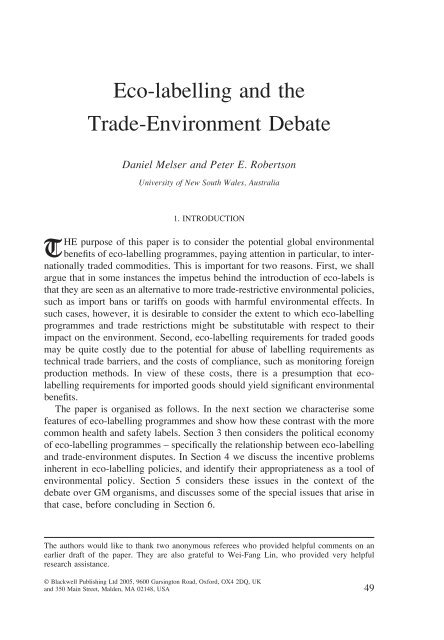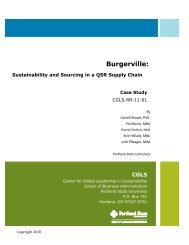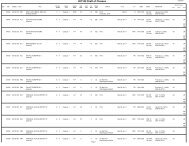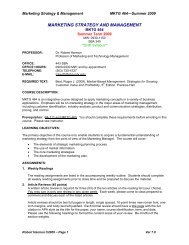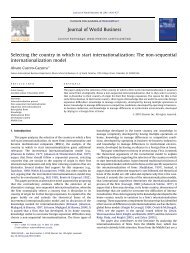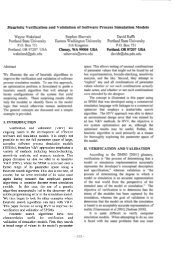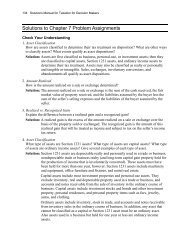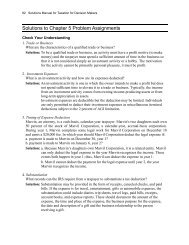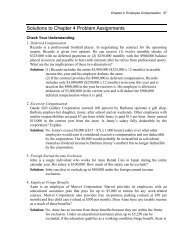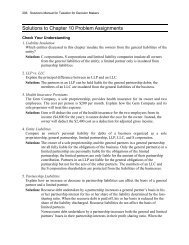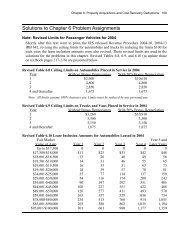Eco-labelling and the Trade-Environment Debate
Eco-labelling and the Trade-Environment Debate
Eco-labelling and the Trade-Environment Debate
You also want an ePaper? Increase the reach of your titles
YUMPU automatically turns print PDFs into web optimized ePapers that Google loves.
ECO-LABELS AND TRADE 49<br />
<strong>Eco</strong>-<strong>labelling</strong> <strong>and</strong> <strong>the</strong><br />
<strong>Trade</strong>-<strong>Environment</strong> <strong>Debate</strong><br />
Daniel Melser <strong>and</strong> Peter E. Robertson<br />
University of New South Wales, Australia<br />
1. INTRODUCTION<br />
THE purpose of this paper is to consider <strong>the</strong> potential global environmental<br />
benefits of eco-<strong>labelling</strong> programmes, paying attention in particular, to internationally<br />
traded commodities. This is important for two reasons. First, we shall<br />
argue that in some instances <strong>the</strong> impetus behind <strong>the</strong> introduction of eco-labels is<br />
that <strong>the</strong>y are seen as an alternative to more trade-restrictive environmental policies,<br />
such as import bans or tariffs on goods with harmful environmental effects. In<br />
such cases, however, it is desirable to consider <strong>the</strong> extent to which eco-<strong>labelling</strong><br />
programmes <strong>and</strong> trade restrictions might be substitutable with respect to <strong>the</strong>ir<br />
impact on <strong>the</strong> environment. Second, eco-<strong>labelling</strong> requirements for traded goods<br />
may be quite costly due to <strong>the</strong> potential for abuse of <strong>labelling</strong> requirements as<br />
technical trade barriers, <strong>and</strong> <strong>the</strong> costs of compliance, such as monitoring foreign<br />
production methods. In view of <strong>the</strong>se costs, <strong>the</strong>re is a presumption that eco<strong>labelling</strong><br />
requirements for imported goods should yield significant environmental<br />
benefits.<br />
The paper is organised as follows. In <strong>the</strong> next section we characterise some<br />
features of eco-<strong>labelling</strong> programmes <strong>and</strong> show how <strong>the</strong>se contrast with <strong>the</strong> more<br />
common health <strong>and</strong> safety labels. Section 3 <strong>the</strong>n considers <strong>the</strong> political economy<br />
of eco-<strong>labelling</strong> programmes – specifically <strong>the</strong> relationship between eco-<strong>labelling</strong><br />
<strong>and</strong> trade-environment disputes. In Section 4 we discuss <strong>the</strong> incentive problems<br />
inherent in eco-<strong>labelling</strong> policies, <strong>and</strong> identify <strong>the</strong>ir appropriateness as a tool of<br />
environmental policy. Section 5 considers <strong>the</strong>se issues in <strong>the</strong> context of <strong>the</strong><br />
debate over GM organisms, <strong>and</strong> discusses some of <strong>the</strong> special issues that arise in<br />
that case, before concluding in Section 6.<br />
The authors would like to thank two anonymous referees who provided helpful comments on an<br />
earlier draft of <strong>the</strong> paper. They are also grateful to Wei-Fang Lin, who provided very helpful<br />
research assistance.<br />
© Blackwell Publishing Ltd 2005, 9600 Garsington Road, Oxford, OX4 2DQ, UK<br />
© <strong>and</strong> Blackwell 350 Main Publishing Street, Malden, Ltd 2005 MA 02148, USA 49
50 DANIEL MELSER AND PETER E. ROBERTSON<br />
2. CHARACTERISTICS OF ECO-LABELLING PROGRAMMES<br />
<strong>Eco</strong>-<strong>labelling</strong> is a relatively recent phenomenon having grown in popularity<br />
world-wide since Germany’s Blue Angel eco-label was introduced in 1977. 1<br />
By 1992, eco-<strong>labelling</strong> was explicitly endorsed by <strong>the</strong> 156 countries who were<br />
signatories to Agenda 21, at <strong>the</strong> Earth Summit (United Nations Conference on<br />
<strong>Environment</strong> <strong>and</strong> Development, Rio de Janeiro, 1992); Appleton (1997). These<br />
eco-<strong>labelling</strong> programmes are aimed at conserving environmental resources through<br />
various channels such as promoting consumer awareness, creating markets for<br />
green goods <strong>and</strong> providing consumers with <strong>the</strong> ability to make informed choices. 2<br />
In some respects <strong>the</strong> practice of eco-<strong>labelling</strong> is very similar to <strong>the</strong> more<br />
widespread practice of health <strong>and</strong> safety <strong>labelling</strong>. Clearly both require producers<br />
to comply with <strong>labelling</strong> requirements that help consumers make informed choices.<br />
With respect to international trade policy, <strong>the</strong>y pose similar problems in that both<br />
may require an importing country to insist that foreign exporters meet <strong>labelling</strong><br />
requirements, thus having <strong>the</strong> potential to be misused as technical trade barriers. 3<br />
A significant amount of attention has focused on <strong>the</strong> potential for health <strong>and</strong><br />
safety labels to be misused as a technical barrier to trade, <strong>and</strong> this concern<br />
remains for eco-labels (OECD, 1997, 2003; <strong>and</strong> WTO, 1998).<br />
Never<strong>the</strong>less <strong>the</strong>re are several aspects of eco-<strong>labelling</strong> policies that make <strong>the</strong>m<br />
different <strong>and</strong> more controversial than health <strong>and</strong> safety labels. First, whereas<br />
health <strong>and</strong> safety issues tend to be relatively homogeneous across countries,<br />
attitudes toward <strong>the</strong> environment may differ widely. Hence <strong>the</strong>re is often scope<br />
for disagreement between countries over <strong>the</strong> validity of a specific requirement.<br />
Moreover, since dem<strong>and</strong> for environmental quality tends to be income elastic,<br />
<strong>the</strong>se differences in attitude are often greatest between developed <strong>and</strong> less<br />
developed countries. In this sense, <strong>the</strong> motive for eco-<strong>labelling</strong> requirements<br />
on internationally traded commodities may be viewed with more suspicion by<br />
developing-country exporters than o<strong>the</strong>r types of labels. This concern is heightened<br />
for m<strong>and</strong>atory eco-<strong>labelling</strong> requirements describing harmful environmental<br />
characteristics of <strong>the</strong> good, but may also hold for voluntary programmes. 4<br />
1 The Blue Angel was followed by over 30 national eco-<strong>labelling</strong> programmes with <strong>the</strong> USA alone<br />
having over 20 eco-<strong>labelling</strong> schemes in a wide range of industries (WTO, 2000).<br />
2 For a broader discussion of eco-<strong>labelling</strong> see Vossenaar (1997), Childs <strong>and</strong> Whiting (1998), Dosi<br />
<strong>and</strong> Moretto (1998), Shams (1995), Mason (2001) <strong>and</strong> Mattoo <strong>and</strong> Singh (1997).<br />
3 The Technical Barriers to <strong>Trade</strong> (TBT) Agreement explicitly mentions <strong>labelling</strong> requirements. As<br />
stated in <strong>the</strong> preamble, <strong>the</strong> aim of <strong>the</strong> TBT Agreement is, ‘. . . to ensure that technical regulations<br />
<strong>and</strong> st<strong>and</strong>ards, including packaging, marking <strong>and</strong> <strong>labelling</strong> requirements, <strong>and</strong> procedures for assessment<br />
of conformity with technical regulations <strong>and</strong> st<strong>and</strong>ards do not create unnecessary obstacles to<br />
international trade’.<br />
4 In a voluntary programme <strong>the</strong> organising body, usually a government agency, sets a st<strong>and</strong>ard, <strong>and</strong><br />
products meeting <strong>the</strong>se st<strong>and</strong>ards are permitted to use <strong>the</strong> eco-label. The programmes are typically<br />
<strong>the</strong>refore voluntary, in <strong>the</strong> sense that producers can choose whe<strong>the</strong>r or not <strong>the</strong>y want to meet <strong>the</strong><br />
© Blackwell Publishing Ltd 2005
ECO-LABELS AND TRADE 51<br />
Second, since eco-labels contain information regarding potential environmental<br />
impacts, <strong>the</strong>y are designed to inform consumers about costs that occur at <strong>the</strong><br />
production <strong>and</strong> disposal stages of a product’s life-cycle. This contrasts with health<br />
<strong>and</strong> safety labels that are typically concerned with costs that are incurred during<br />
consumption. This difference is important from <strong>the</strong> perspective of international<br />
trade, since WTO rules exclude trade policy measures based solely on different<br />
process <strong>and</strong> production methods (PPMs). <strong>Eco</strong>-<strong>labelling</strong> information, however,<br />
will often refer to precisely <strong>the</strong>se criteria, <strong>and</strong> this has implications for <strong>the</strong> political<br />
economy of eco-<strong>labelling</strong> discussed in Section 3 below.<br />
The third factor is <strong>the</strong> difference in incentives. Health <strong>and</strong> safety labels convey<br />
information about various attributes <strong>and</strong> effects of <strong>the</strong> product on <strong>the</strong> consumer.<br />
Examples include <strong>the</strong> possible allergenicity of a food product or <strong>the</strong> cancercausing<br />
effects of cigarettes. The effectiveness of health <strong>and</strong> safety <strong>labelling</strong><br />
<strong>the</strong>refore depends on a consumer’s willingness to pay a premium to protect <strong>the</strong>ir<br />
own well-being. <strong>Eco</strong>-<strong>labelling</strong>, however, depends on consumers’ willingness to<br />
protect <strong>the</strong> environment. Thus eco-<strong>labelling</strong> depends implicitly on consumers’<br />
desires to contribute to <strong>the</strong> wellbeing of o<strong>the</strong>rs as <strong>the</strong> environment is a shared<br />
resource. Clearly <strong>the</strong> incentives facing <strong>the</strong> consumers in each case are quite different.<br />
We will argue in Section 4 that even a perfectly monitored eco-<strong>labelling</strong><br />
scheme cannot be relied upon to prevent excess environmental damage, due to<br />
<strong>the</strong> ‘tragedy of <strong>the</strong> commons’. However, we defer fur<strong>the</strong>r discussion of this issue<br />
<strong>and</strong> first consider <strong>the</strong> role of eco-<strong>labelling</strong> in international trade disputes.<br />
3. BARRIERS TO TRADE, THE WTO AND ECO-LABELS<br />
a. <strong>Trade</strong> <strong>and</strong> <strong>Environment</strong> Disputes<br />
Recent environmental disputes brought before <strong>the</strong> WTO have highlighted<br />
<strong>the</strong> conflict faced by governments who wish to pursue domestic environmental<br />
policies <strong>and</strong> also comply with WTO rules. 5 First, as mentioned above, <strong>the</strong> WTO<br />
principles of non-discrimination require that like products are treated equally<br />
irrespective of <strong>the</strong> country of origin. 6 This poses a problem for <strong>the</strong> environmental<br />
st<strong>and</strong>ard <strong>and</strong> use <strong>the</strong> eco-label. In some cases, however, <strong>the</strong> eco-label may be a m<strong>and</strong>atory warning<br />
about negative environmental effects.<br />
5 For a useful <strong>and</strong> contemporary discussion of WTO-environment disputes see Kelly (2003).<br />
6 This principle appears throughout <strong>the</strong> GATT Agreement; for example, consider Article III,<br />
Part 4, which reads, ‘The products of <strong>the</strong> territory of any contracting party imported into <strong>the</strong><br />
territory of any o<strong>the</strong>r contracting party shall be accorded treatment no less favourable than that<br />
accorded to like products of national origin in respect of all laws, regulations <strong>and</strong> requirements<br />
affecting <strong>the</strong>ir internal sale, offering for sale, purchase, transportation, distribution or use.’<br />
© Blackwell Publishing Ltd 2005
52 DANIEL MELSER AND PETER E. ROBERTSON<br />
lobby since it is often <strong>the</strong> production method that differentiates an environmentally<br />
friendly commodity, from one that is not.<br />
The problem became apparent with <strong>the</strong> GATT ‘Tuna-Dolphin’ dispute, where<br />
<strong>the</strong> harvesting of tuna was associated with <strong>the</strong> incidental killing of dolphins by<br />
tuna fishing fleets using purse-seine nets. Under <strong>the</strong> terms of <strong>the</strong> Marine Mammal<br />
Protection Act, <strong>the</strong> USA placed import restrictions on countries with less stringent<br />
tuna-fishing rules than its own. This led <strong>the</strong> EU to file a claim against <strong>the</strong> USA’s<br />
ban on imported tuna under <strong>the</strong> GATT.<br />
The USA case for a ban on tuna caught with purse-seine nets, rested on GATT<br />
Article XX (b) <strong>and</strong> (g), which provide exemptions in <strong>the</strong> case of trade policy<br />
measures, ‘. . . necessary to protect human, animal or plant life or health’ <strong>and</strong><br />
‘relating to <strong>the</strong> conservation of exhaustible natural resources . . .’. Despite <strong>the</strong>se<br />
exceptions, <strong>the</strong> GATT panel found that <strong>the</strong> restrictions were unjustified.<br />
In <strong>the</strong> more recent ‘Shrimp-Turtle’ case, <strong>the</strong> USA required that local shrimp<br />
trawlers use nets fitted with trapdoors, known as turtle excluder devices (TEDs),<br />
to prevent excessive mortality of endangered sea-turtles. 7 The USA attempted to<br />
ban imports of shrimp from South <strong>and</strong> East Asia which is harvested without <strong>the</strong><br />
use of TEDs. In this case, <strong>the</strong> USA was eventually able to have <strong>the</strong> restrictions<br />
upheld, but this decision was reached after a protracted six-year dispute where<br />
both <strong>the</strong> original WTO panel <strong>and</strong> appellate body ruled against <strong>the</strong> USA. 8<br />
b. <strong>Eco</strong>-<strong>labelling</strong> <strong>and</strong> <strong>Trade</strong>-environment Disputes<br />
A legacy of <strong>the</strong>se l<strong>and</strong>mark disputes is a sense of uncertainty surrounding how<br />
environmental <strong>and</strong> trade laws are to be reconciled. Over <strong>the</strong> last decade or more,<br />
governments have thus sought to adopt environmental policies that might satisfy<br />
WTO guidelines. It appears that eco-labels may be suitable policy instruments.<br />
Currently <strong>the</strong> WTO Committee on <strong>Trade</strong> <strong>and</strong> <strong>Environment</strong> (CTE) has been considering<br />
<strong>the</strong> issues surrounding eco-<strong>labelling</strong> after urging from member states in<br />
recent submissions (WTO, 2002; <strong>and</strong> WTO, 2003a). Part of <strong>the</strong> Doha Ministerial<br />
Declaration, prepared by <strong>the</strong> CTE (WTO, 2003b), summarises members’ opinions<br />
on this issue:<br />
Most Members agreed that voluntary, participatory, market-based <strong>and</strong> transparent environmental<br />
<strong>labelling</strong> schemes were potentially efficient economic instruments in order to inform consumers<br />
about environmentally friendly products. As such <strong>the</strong>y could help move consumption on to a<br />
7 The TEDs cost between US$75 <strong>and</strong> US$500. It was estimated that shrimp catches fell by around<br />
two per cent with its introduction <strong>and</strong> turtle mortality by around 97 per cent; Ranné (1999).<br />
8 Somewhat ironically, <strong>the</strong> resolution of this dispute in favour of <strong>the</strong> US environmental movement<br />
has been followed by anti-dumping duties of around 100 per cent on Chinese <strong>and</strong> Vietnamese<br />
shrimp, <strong>and</strong> similar duties are likely to be imposed on o<strong>the</strong>r East Asian countries; The <strong>Eco</strong>nomist<br />
(2004b).<br />
© Blackwell Publishing Ltd 2005
ECO-LABELS AND TRADE 53<br />
more sustainable footing. Moreover, <strong>the</strong>y tended, generally, to be less trade restrictive than<br />
o<strong>the</strong>r instruments. [original emphasis] (WTO, 2003b, p. 8). 9<br />
Thus, whereas WTO rules explicitly try to prevent m<strong>and</strong>ated discrimination on<br />
<strong>the</strong> basis of production methods, eco-labels provide an opportunity for consumers<br />
to discriminate. In view of this, eco-<strong>labelling</strong> policies, <strong>and</strong> in particular voluntary<br />
programmes, potentially offer some room for compromise between <strong>the</strong> dem<strong>and</strong>s<br />
of <strong>the</strong> environmental lobby <strong>and</strong> WTO principles.<br />
For example, in <strong>the</strong> Forestry industry, eco-<strong>labelling</strong>, in <strong>the</strong> form of forestry<br />
certification arose in response to numerous calls for trade bans <strong>and</strong> consumer<br />
boycotts of <strong>the</strong> international trade in tropical timber during <strong>the</strong> 1980s. Timber<br />
accounts for a large fraction of developing countries’ output, <strong>and</strong> most of this is<br />
exported. Hence international trade <strong>and</strong> growth is seen as a catalyst for deforestation.<br />
10 In response to <strong>the</strong>se concerns, in 1992 Austria raised tariffs on unsustainably<br />
managed timber by 70 per cent <strong>and</strong> also introduced a compulsory eco-<strong>labelling</strong><br />
scheme. Shortly after, however, <strong>the</strong> tariff was dropped because of concern about its<br />
GATT legality <strong>and</strong> <strong>the</strong> eco-<strong>labelling</strong> scheme became voluntary; Crossley (1996). 11<br />
In a similar vein, eco-<strong>labelling</strong> programmes were introduced as a direct result<br />
of <strong>the</strong> USA failure to impose trade measures on imported Mexican tuna; WTO<br />
(1998). Likewise <strong>the</strong>y were also called for as a resolution to <strong>the</strong> Shrimp-Turtle<br />
dispute, <strong>and</strong> were introduced to a limited extent. These examples suggest, <strong>the</strong>refore,<br />
that eco-<strong>labelling</strong> programmes have been used as a politically expedient<br />
policy option for governments caught between pressure from national environmental<br />
lobbies <strong>and</strong> pressure from exporters <strong>and</strong> foreign governments to comply<br />
with WTO rules.<br />
The difficulty is that <strong>the</strong>re is very little discussion over what <strong>the</strong> expected<br />
benefits of eco-<strong>labelling</strong> are. The concern must <strong>the</strong>n arise as to whe<strong>the</strong>r eco<strong>labelling</strong><br />
policies might be adopted in place of more m<strong>and</strong>atory, but less WTOcompliant<br />
policies, without evaluation of <strong>the</strong> environmental consequences. In <strong>the</strong><br />
next section we discuss <strong>the</strong> consequences of using eco-<strong>labelling</strong> as an environmental<br />
policy tool.<br />
9 It is interesting to note that <strong>the</strong> CTE added, ‘One Member questioned <strong>the</strong> assumption that<br />
comprehensive <strong>labelling</strong> schemes had a positive effect on achieving good environmental outcomes’<br />
(WTO, 2003b, p. 8). This is <strong>the</strong> point that we hope to develop in this paper.<br />
10 In 1990 Indonesia (60 per cent) <strong>and</strong> Malaysia (75 per cent) both exported a large proportion of<br />
<strong>the</strong>ir timber. Moreover, Indonesia <strong>and</strong> Malaysia account for 65 per cent of world tropical timber<br />
exports. The major importers are Japan <strong>and</strong> <strong>the</strong> EU, toge<strong>the</strong>r accounting for 48 per cent of world<br />
imports in 1987. Similarly Japan, <strong>the</strong> EU <strong>and</strong> <strong>the</strong> USA account for over 70 per cent of wood<br />
furniture imports. Thus, although domestic consumption is an important factor in explaining deforestation,<br />
in particular for fuel, <strong>the</strong> role of foreign dem<strong>and</strong> is also significant; Crossley et al. (1997).<br />
11 Crossley et al. (1997) report that <strong>the</strong>re were seven national certification schemes in operation in<br />
1994, although <strong>the</strong>ir coverage is very small relative to total timber trade. Swallow <strong>and</strong> Sedjo (2000)<br />
discuss <strong>the</strong> commercial impact of timber certification on <strong>the</strong> forestry industry <strong>and</strong> on developing<br />
country exports.<br />
© Blackwell Publishing Ltd 2005
54 DANIEL MELSER AND PETER E. ROBERTSON<br />
4. THE ENVIRONMENTAL EFFECTS OF ECO-LABELLING<br />
a. <strong>Eco</strong>-labels as a Tool to Create Markets for Green Goods<br />
The potential benefit of eco-<strong>labelling</strong> policies is put succinctly by The<br />
<strong>Eco</strong>nomist:<br />
The right way to deal with people’s desire to eat turtle-friendly shrimp, hormone-free beef or<br />
whatever is not to impose one country’s values on ano<strong>the</strong>r: it is to label <strong>the</strong> products appropriately.<br />
Consumers, not governments, can <strong>the</strong>n choose what <strong>the</strong>y eat, <strong>and</strong> trade can remain free.<br />
(The <strong>Eco</strong>nomist, 7 October, 1999).<br />
To make this argument concrete, consider a consumer’s choice over two br<strong>and</strong>s<br />
of shrimp, say Brown <strong>and</strong> Green. Brown involves <strong>the</strong> incidental killing of sea turtles<br />
during harvesting <strong>and</strong> Green is <strong>the</strong> eco-labelled product which is harvested with<br />
nets that have TEDs (which, for simplicity, we suppose eliminates turtle deaths).<br />
We naturally assume that <strong>the</strong> price of Green exceeds Brown, o<strong>the</strong>rwise <strong>the</strong>re<br />
would be no dem<strong>and</strong> for Brown.<br />
For <strong>the</strong> purpose of this discussion it does not matter whe<strong>the</strong>r <strong>the</strong> label is a<br />
m<strong>and</strong>atory requirement on Brown, or a voluntary label on Green, as long as <strong>the</strong><br />
information on <strong>the</strong> label is credible. The choice facing a consumer is depicted<br />
in Figure 1. Here <strong>the</strong> dem<strong>and</strong> curve of <strong>the</strong> consumer for Brown <strong>and</strong> Green is<br />
depicted by dd′, which is <strong>the</strong> same for both goods as from a consumption<br />
perspective <strong>the</strong>se goods are indistinguishable. The consumer’s marginal costs of<br />
consuming Green is simply equal to <strong>the</strong> price, p G . The marginal costs of consuming<br />
Brown, however, is <strong>the</strong> sum of <strong>the</strong> price of Brown (p B < p G ) <strong>and</strong> <strong>the</strong> private<br />
disutility <strong>the</strong> consumer derives from environmental damage, <strong>and</strong> is given by <strong>the</strong><br />
schedule s. There are two possible reasons why this schedule lies above p B : (i) <strong>the</strong><br />
consumer may correctly perceive that <strong>the</strong>ir consumption decision has a small, but<br />
non-zero, effect on <strong>the</strong> environment which generates some loss of utility, <strong>and</strong> (ii)<br />
<strong>the</strong> consumer may face some psychic costs of knowingly causing environmental<br />
damage, such as guilt or peer pressure.<br />
The horizontal axis in Figure 1 shows <strong>the</strong> quantity purchased by <strong>the</strong> consumer,<br />
<strong>and</strong> hence also <strong>the</strong> damage caused by this consumer. In choosing whe<strong>the</strong>r to<br />
purchase Green or Brown <strong>the</strong> consumer compares <strong>the</strong> surplus from each commodity.<br />
For Green this is given by <strong>the</strong> triangle dfp G <strong>and</strong> for Brown it is dep B .<br />
The difference in <strong>the</strong> two regions is given by <strong>the</strong> difference between <strong>the</strong> two<br />
shaded regions. As drawn in Figure 1, <strong>the</strong> consumer will choose Brown. It can be<br />
seen that <strong>the</strong> decision depends on <strong>the</strong> position of <strong>the</strong> marginal cost schedule<br />
s. This in turn depends on <strong>the</strong> price of Brown, <strong>and</strong> <strong>the</strong> consumer’s dislike for<br />
killing sea turtles. <strong>Environment</strong>al preservation thus depends on enough consumers<br />
having a strong-enough preference for <strong>the</strong> particular environmental service, <strong>and</strong><br />
on <strong>the</strong> cost of <strong>the</strong> Green eco-labelled substitute not being too much greater than<br />
Brown.<br />
© Blackwell Publishing Ltd 2005
ECO-LABELS AND TRADE 55<br />
FIGURE 1<br />
<strong>Eco</strong>-labels <strong>and</strong> Consumer Choice<br />
b. <strong>Eco</strong>-labels <strong>and</strong> External <strong>Environment</strong>al Costs<br />
Despite <strong>the</strong> beneficial effect of eco-labels in creating markets for green<br />
goods, <strong>the</strong>re remains a concern whe<strong>the</strong>r <strong>the</strong> self-interest motive provides a strongenough<br />
impetus for consumers to act to reduce environmental costs. The preceding<br />
argument implicitly assumes that <strong>the</strong> production or consumption of <strong>the</strong><br />
commodities in question, create no external costs. In <strong>the</strong> shrimp example, however,<br />
<strong>the</strong> main point of <strong>the</strong> USA opposition to incidental killing of sea-turtles<br />
is that <strong>the</strong>y are an endangered species, with all but one species of sea turtle<br />
currently threatened with extinction; Liebig (1999). In general it has been argued<br />
that species’ extinction generates significant external costs, through <strong>the</strong> loss of<br />
biodiversity <strong>and</strong> <strong>the</strong> loss of part of <strong>the</strong> ‘global heritage of humanity’; Ferrantino<br />
(1997). 12<br />
12 Perhaps <strong>the</strong> best example of <strong>the</strong> use of eco-<strong>labelling</strong> for a product where <strong>the</strong> information concerns<br />
potentially large external costs, is in Forestry Certification. Specifically this was designed to<br />
reduce deforestation of tropical hardwoods that are associated with two important trans-national<br />
externalities: <strong>the</strong> effect on <strong>the</strong> carbon cycle <strong>and</strong> climate change, <strong>and</strong> bio-diversity; Simula (1997).<br />
In general, however, <strong>the</strong> significance of <strong>the</strong>se implied external costs is open to debate, <strong>and</strong> needs to<br />
be assessed on a case-by-case basis.<br />
© Blackwell Publishing Ltd 2005
56 DANIEL MELSER AND PETER E. ROBERTSON<br />
FIGURE 2<br />
The <strong>Environment</strong>al Effects of <strong>Eco</strong>-<strong>labelling</strong><br />
Viewed in this way it is apparent that <strong>the</strong> hormone-free-beef <strong>and</strong> turtle-friendlyshrimp<br />
problems are actually quite different. <strong>Eco</strong>-labels in <strong>the</strong> latter case provide<br />
consumers with information about <strong>the</strong> costs or benefits of production that are<br />
external to <strong>the</strong> consumer. Since, almost by definition, environmental services are<br />
public goods, this is a general feature of eco-labels.<br />
To see this more formally, suppose that <strong>the</strong> Brown good has an individual<br />
effect on <strong>the</strong> environment as perceived by <strong>the</strong> consumer, <strong>and</strong> reflected in s, <strong>and</strong><br />
also an effect on <strong>the</strong> environment which is borne by all consumers. This is<br />
illustrated in Figure 2 where <strong>the</strong> social costs of <strong>the</strong> purchase of <strong>the</strong> Brown good<br />
are given by s* <strong>and</strong> lie above s.<br />
The analysis is similar to <strong>the</strong> st<strong>and</strong>ard public good model, since purchasing <strong>the</strong><br />
Green good is equivalent to paying a subscription to <strong>the</strong> maintenance of a public<br />
good, in this case <strong>the</strong> environment. However, because individuals only consider<br />
<strong>the</strong> benefits of such a subscription on <strong>the</strong>mselves <strong>the</strong>re will be too few consumers<br />
of <strong>the</strong> Green good <strong>and</strong> too many of Brown. 13 Thus it can be seen in Figure 2 that<br />
13 Robertson (2002) contains a formal analysis of free riding behaviour <strong>and</strong> finds that <strong>the</strong> number<br />
of countries signing onto international eco-<strong>labelling</strong> agreements may have little or no effect on <strong>the</strong><br />
environment.<br />
© Blackwell Publishing Ltd 2005
ECO-LABELS AND TRADE 57<br />
<strong>the</strong> social surplus from <strong>the</strong> consumption of Brown is smaller than <strong>the</strong> private<br />
surplus, shown in Figure 1. The reduction in <strong>the</strong> social surplus of Brown relative<br />
to Green implies that in <strong>the</strong> free market equilibrium <strong>the</strong>re are too few consumers<br />
of Green <strong>and</strong> too many of Brown. Indeed as depicted in Figure 2 <strong>the</strong> difference<br />
between <strong>the</strong> social surplus from consuming <strong>the</strong> Green <strong>and</strong> Brown goods is now<br />
in Green’s favour in contrast to Figure 1.<br />
c. Policy <strong>and</strong> Political Implications<br />
Despite <strong>the</strong> limitations of eco-<strong>labelling</strong> programmes, <strong>the</strong>y appear to be increasing<br />
in popularity. As suggested above, this may be due to <strong>the</strong> political expedience<br />
of eco-<strong>labelling</strong> policies. In particular, when an environmental problem is international<br />
in scope, <strong>the</strong> usual policy tools for internalising external costs don’t<br />
exist. A country is limited to imposing trade measures aimed at minimising<br />
environmental damage, or to international cooperation, through multilateral environmental<br />
agreements. The first avenue is likely to violate WTO rules <strong>and</strong> <strong>the</strong><br />
second is likely to be very costly with a highly uncertain outcome. Thus <strong>the</strong><br />
introduction of eco-<strong>labelling</strong> regimes that apply to internationally traded goods,<br />
may simply be a policy of last resort, that avoids WTO conflict <strong>and</strong> makes some<br />
concessions to <strong>the</strong> environmental lobby.<br />
Our preceding analysis suggests that whe<strong>the</strong>r or not a given eco-<strong>labelling</strong><br />
regime is an appropriate policy, or an inappropriate but perhaps politically expedient<br />
one, depends on <strong>the</strong> extent of <strong>the</strong> divergence between social <strong>and</strong> private<br />
environmental costs, s* <strong>and</strong> s, associated with <strong>the</strong> commodity being subjected to<br />
eco-<strong>labelling</strong> requirements. For example, an eco-label on tuna, indicating whe<strong>the</strong>r<br />
it is dolphin friendly, may be a reasonable policy if it is accepted that dolphin<br />
mortality has no particular external environmental costs, perhaps since <strong>the</strong>y are<br />
not endangered. Such a label would increase <strong>the</strong> utility of dolphin-squeamish<br />
consumers. In this case, <strong>the</strong> introduction of eco-<strong>labelling</strong> may be an appropriate<br />
response to <strong>the</strong> trade dispute. Never<strong>the</strong>less, since <strong>the</strong>re are no significant external<br />
environmental costs, this ‘eco-label’ is more akin to a personal health warning. In<br />
cases where externalities exist, however, it would be desirable to attempt to<br />
quantify <strong>the</strong>se social costs before determining whe<strong>the</strong>r or not eco-<strong>labelling</strong> is an<br />
appropriate policy. If <strong>the</strong> external costs are indeed significant, <strong>the</strong>n eco-<strong>labelling</strong><br />
at best should be part of a broader policy package.<br />
5. ECO-LABELS AND GM FOOD<br />
The preceding analysis also has implications for <strong>the</strong> current debate over trade<br />
in GM food products <strong>and</strong> products derived from GM crops. The production of<br />
GM crops has increased rapidly over <strong>the</strong> last decade, particularly in <strong>the</strong> USA,<br />
© Blackwell Publishing Ltd 2005
58 DANIEL MELSER AND PETER E. ROBERTSON<br />
Canada <strong>and</strong> Argentina. 14 This has been associated with fears about <strong>the</strong> effects of<br />
GM products, resulting in trade bans by <strong>the</strong> EU in particular. Thus, aspects of<br />
this debate are strongly reminiscent of <strong>the</strong> forestry <strong>and</strong> fishing examples we cite<br />
above. Never<strong>the</strong>less, <strong>the</strong>re are also some important differences which we explore<br />
in this section.<br />
a. Background: GMOs <strong>and</strong> <strong>the</strong> <strong>Trade</strong> Conflict Between <strong>the</strong> USA <strong>and</strong> <strong>the</strong> EU<br />
In 1999 <strong>the</strong> EU introduced a moratorium on <strong>the</strong> importation of new GMOs<br />
into its territories. In a formal complaint with <strong>the</strong> WTO in May 2003, <strong>the</strong> USA,<br />
Canada <strong>and</strong> Argentina cited two objections to <strong>the</strong> EU policy. Firstly, <strong>the</strong>y claim<br />
<strong>the</strong>re is a lack of scientific evidence that GM foods are harmful to people or <strong>the</strong><br />
environment, which means in turn that <strong>the</strong> moratorium cannot be justified under<br />
<strong>the</strong> Agreement on Sanitary <strong>and</strong> Phytosanitary Measures (SPS) or Article XX.<br />
Secondly, <strong>the</strong> moratorium violates <strong>the</strong> PPM rules. According to <strong>the</strong> USA, GM<br />
foods <strong>and</strong> non-GM foods are like products, or ‘substantially equivalent’, <strong>and</strong> <strong>the</strong><br />
EU moratorium discriminates according to PPMs. 15<br />
As in our preceding examples, <strong>the</strong> EU responded to this political pressure by<br />
introducing a requirement that all products which contain an ingredient which<br />
includes more than 0.9 per cent GMOs, be labelled. 16 With this extended <strong>labelling</strong><br />
policy in place since late 2003, <strong>the</strong> moratorium was <strong>the</strong>n allowed to expire in<br />
May 2004 (Greenpeace, 2003; <strong>and</strong> The <strong>Eco</strong>nomist, 2004a). Thus in terms of <strong>the</strong><br />
political pressure for <strong>labelling</strong>, <strong>the</strong> GM case is very similar to <strong>the</strong> shrimp, tuna<br />
<strong>and</strong> forestry examples.<br />
b. Aspects of <strong>the</strong> GM <strong>Debate</strong><br />
There are, however, several peculiarities with <strong>the</strong> current GM debate. First, <strong>the</strong><br />
<strong>labelling</strong> programme is a m<strong>and</strong>atory policy – all producers of GM foods must<br />
comply with <strong>the</strong> label. This is contentious since it means <strong>the</strong> policy places <strong>the</strong><br />
burden of compliance on foreign producers. Arguably, <strong>the</strong>refore, it has greater<br />
potential to be used as a technical trade barrier than, say, a voluntary ‘GM Free’<br />
label would. Never<strong>the</strong>less, from <strong>the</strong> perspective of <strong>the</strong> GM-producing countries,<br />
it is more desirable than <strong>the</strong> moratorium. In this sense <strong>the</strong> policy can <strong>the</strong>refore<br />
14 In 1995 <strong>the</strong>re were virtually no GM crops. In 2002, <strong>the</strong>re were 59 million hectares of transgenic<br />
crops grown globally. Most of this was grown in only four countries: USA (66 per cent), Argentina<br />
(23 per cent), Canada (6 per cent) <strong>and</strong> China (4 per cent) <strong>and</strong> is dominated by just three crops,<br />
soybean (62 per cent), maize (21 per cent) <strong>and</strong> cotton (12 per cent); James (2002).<br />
15 For fur<strong>the</strong>r discussion of <strong>the</strong> issues see Sheldon (2002).<br />
16 In fact <strong>labelling</strong> of GM products is widespread with 26 countries ei<strong>the</strong>r having <strong>labelling</strong> regimes<br />
or planning to introduce <strong>the</strong>m; Phillips <strong>and</strong> McNeil (2000).<br />
© Blackwell Publishing Ltd 2005
ECO-LABELS AND TRADE 59<br />
still be viewed as an attempted political compromise between <strong>the</strong> interests of GM<br />
producers <strong>and</strong> <strong>the</strong> environmental lobby.<br />
The second aspect of this debate concerns <strong>the</strong> factors that are driving consumer<br />
dem<strong>and</strong>s for <strong>labelling</strong>. Though <strong>the</strong> consumers’ ‘right to know’ might be<br />
cited as <strong>the</strong> direct reason, <strong>the</strong> question remains as to what extent <strong>the</strong> dem<strong>and</strong> for<br />
information is being driven by fears for personal safety, <strong>and</strong> to what extent <strong>the</strong>y<br />
are driven by concerns for <strong>the</strong> environment. 17 The extensive consultation undertaken<br />
by <strong>the</strong> UK’s GM Science Review Panel (2003) suggests that <strong>the</strong> principle<br />
dem<strong>and</strong> for <strong>labelling</strong> of GM products is due to a concern for personal health.<br />
Thus, though <strong>the</strong>se concerns were strongly rejected by <strong>the</strong> Panel, it appears that,<br />
for many consumers, <strong>the</strong> <strong>labelling</strong> of GM products is akin to a health <strong>and</strong> safety<br />
warning. 18<br />
Never<strong>the</strong>less, <strong>the</strong>re is also considerable discussion of <strong>the</strong> possible negative<br />
effects on <strong>the</strong> environment of GM crops. These include (i) <strong>the</strong> potential dispersal<br />
of <strong>the</strong> genetically modified organisms in <strong>the</strong> environment – for example through<br />
invasiveness; (ii) <strong>the</strong> potential transfer of <strong>the</strong> inserted genetic material to o<strong>the</strong>r<br />
organisms – for example through cross-pollination; (iii) potential impacts on<br />
non-target species; <strong>and</strong> (iv) potential impacts on soil bacteria <strong>and</strong> <strong>the</strong> nitrogen<br />
cycle (European <strong>Environment</strong> Agency, 2002; <strong>and</strong> Mackenzie et al., 2003).<br />
Similar concerns about <strong>the</strong> irreversible effects of cross-contamination have been<br />
voiced by groups such as Greenpeace, Friends of <strong>the</strong> Earth <strong>and</strong> GeneWatch<br />
UK (Greenpeace, 2003; Friends of <strong>the</strong> Earth, 2004; <strong>and</strong> GeneWatch UK, 2001). 19<br />
Though <strong>the</strong> GM Science Review Panel downplays such fears, it also warns that<br />
environmental risk factors of GM crops may prove to be more challenging in<br />
future, as more GM crops are developed; GM Science Review Panel (2003).<br />
In conclusion, <strong>the</strong>refore, though personal safety issues, such as exposure to<br />
unknown allergens, remain perhaps <strong>the</strong> principal source of consumer concern<br />
over GM foods, <strong>the</strong> environmental factors cannot be ignored. This means that<br />
labels on GM foods serve two purposes – a potential health <strong>and</strong> safety label as<br />
well as an eco-label.<br />
17 One striking example of <strong>the</strong> depth of consumer concern can be seen in Europe where a<br />
Eurobarometer (2001) survey of 16,029 people in <strong>the</strong> 15 member states reported that 94.6 per cent<br />
of people believed <strong>the</strong>y should have <strong>the</strong> right to choose with regard to GM foods – implying that<br />
<strong>the</strong>se foods should be labelled.<br />
18 The GM Science Review Panel (2003, p. 22) noted that, ‘. . . for human health to date <strong>the</strong>re is no<br />
evidence currently commercialised GM crop varieties or foods made from <strong>the</strong>m, are toxic, allergenic<br />
or nutritionally deleterious’.<br />
19 According to Greenpeace (2003), ‘GM crops pose irreversible long-term risks to <strong>the</strong> environment.<br />
It is possible for GM crops to transfer modified genes to closely related plant species ...This<br />
is particularly worrying because GM oilseed rape <strong>and</strong> sugar beet have wild relatives in <strong>the</strong> UK –<br />
any contamination of <strong>the</strong>se wild species would be irreversible.’<br />
© Blackwell Publishing Ltd 2005
60 DANIEL MELSER AND PETER E. ROBERTSON<br />
c. An Appropriate Policy Regime for GM Products<br />
Though <strong>the</strong> moratorium on GM foods in <strong>the</strong> EU has been lifted, decisions on<br />
individual GM crops are now made on a case-by-case basis by <strong>the</strong> European<br />
Commission; The <strong>Eco</strong>nomist (2004a). Thus <strong>the</strong> EU still remains a long way from<br />
‘free trade’ in GM products. The analysis above suggests that <strong>labelling</strong> requirements<br />
on GM products are an appropriate response for <strong>the</strong> health <strong>and</strong> safety<br />
concerns of consumers, but not for <strong>the</strong> environmental concerns expressed by<br />
lobby groups. In principle, <strong>the</strong>refore, an informed discussion on <strong>the</strong>se issues<br />
should consider <strong>the</strong> environmental <strong>and</strong> personal health concerns separately, <strong>and</strong><br />
form policies based on <strong>the</strong> perceived attributes of each product. If <strong>the</strong> concerns<br />
over a GM product extend only as far as personal health issues associated with its<br />
consumption or disposal, <strong>the</strong>n <strong>labelling</strong> policies may be all that is required. If<br />
concerns extend to local or global environmental costs, <strong>the</strong>n alternative regulations<br />
need to be considered.<br />
6. CONCLUSION<br />
Underst<strong>and</strong>ing <strong>the</strong> potential benefits of eco-<strong>labelling</strong> policies is particularly<br />
important for internationally traded goods, where <strong>the</strong> potential exists for <strong>the</strong><br />
misuse of <strong>labelling</strong> as a technical trade barrier. Moreover, in several high-profile<br />
cases, eco-<strong>labelling</strong> was adopted as a substitute for more trade-restrictive measures.<br />
Thus we have argued that eco-<strong>labelling</strong> policies may, in some cases, be<br />
simply a politically expedient way of avoiding <strong>the</strong> difficulties that have arisen<br />
between trade <strong>and</strong> environmental policy objectives. This is a concern, however,<br />
since we have also argued that <strong>the</strong>re are grounds to be pessimistic about <strong>the</strong><br />
ability of eco-labels to solve environmental problems.<br />
Specifically we showed that, while eco-labels can benefit consumers, <strong>the</strong> market<br />
for <strong>the</strong> labelled good will be characterised by damage levels that exceed <strong>the</strong><br />
social optimum, because eco-labels only provide information about costs <strong>and</strong><br />
benefits that are external to each consumer. In some cases, such as <strong>the</strong> GM food<br />
debate, <strong>labelling</strong> information about environmental costs may be only part of <strong>the</strong><br />
objective of a <strong>labelling</strong> programme. Never<strong>the</strong>less, if <strong>the</strong>re are external costs<br />
associated with <strong>the</strong> decision to consume <strong>the</strong> product, even a perfectly monitored<br />
<strong>labelling</strong> scheme will not force consumers to internalise <strong>the</strong>se costs. Hence eco<strong>labelling</strong><br />
should only be seen as a part of a range of policies for environmental<br />
management.<br />
© Blackwell Publishing Ltd 2005
ECO-LABELS AND TRADE 61<br />
REFERENCES<br />
Appleton, A. E. (ed.) (1997), <strong>Environment</strong>al Labelling Programmes: International <strong>Trade</strong><br />
Law Implications. International <strong>Environment</strong>al Law <strong>and</strong> Policy Series (Boston, MA: Kluwer<br />
Law International).<br />
Childs, C. <strong>and</strong> S. Whiting (1998), ‘<strong>Eco</strong>-<strong>labelling</strong> <strong>and</strong> <strong>the</strong> Green Consumer’, Department of<br />
<strong>Environment</strong>al Science (University of Bradford).<br />
Crossley, R. (1996), ‘A Review of Global Management Certification Initiatives: Political <strong>and</strong><br />
Institution Aspects’, Paper for <strong>the</strong> Conference on <strong>Eco</strong>nomic, Social <strong>and</strong> Political Issues in<br />
Certification of Forest Management (Malaysia).<br />
Crossley, R., C. P. Braga <strong>and</strong> P. Varangis (1997), ‘Is <strong>the</strong>re a Commercial Case for Tropical Timber<br />
Certification’, in R. Vossenaar, S. Zarrilli <strong>and</strong> V. Jha (eds.), <strong>Eco</strong>-<strong>labelling</strong> <strong>and</strong> International<br />
<strong>Trade</strong> (Basingstoke: Macmillan Press).<br />
Dosi, C. <strong>and</strong> M. Moretto (1998), ‘Is <strong>Eco</strong>-<strong>labelling</strong> a Reliable <strong>Environment</strong>al Policy Measure?’<br />
(University of Padova, mimeo).<br />
European <strong>Environment</strong> Agency (2002), Genetically Modified Organisms: The Significance of Gene<br />
Flow Through Pollen Transfer, <strong>Environment</strong>al Issue Report, 28.<br />
Eurobarometer (2001), ‘Europeans, Science <strong>and</strong> Technology: Main Results of Eurobarometer’,<br />
Eurobarometer, 55, 2 (December).<br />
Ferrantino, M. J. (1997), ‘International <strong>Trade</strong>, <strong>Environment</strong>al Quality <strong>and</strong> Public Policy’, The<br />
World <strong>Eco</strong>nomy, 20, 1, 43–72.<br />
Friends of <strong>the</strong> Earth (2004), ‘Genetically Modified Crops: A Decade of Failure (1994–2004)’,<br />
(Malaysia: FOE International).<br />
GeneWatch UK (2001), ‘Comments on European Commission’s Proposed Regulations on<br />
GM Good <strong>and</strong> Feed <strong>and</strong> <strong>the</strong> Traceability <strong>and</strong> Labelling of GMOs’ (available at http://<br />
www.genewatch.org/crops<strong>and</strong>food/<strong>labelling</strong>/fsa_evidence.rtf).<br />
GM Science Review Panel (2003), GM Science Review: First Report.<br />
Greenpeace (2003), ‘The European Union’s New Labelling Rules for Genetically Engineered<br />
Food <strong>and</strong> Feed: Implications for <strong>the</strong> Market of GMO <strong>and</strong> Non-GMO Products’ (Greenpeace<br />
European Unit).<br />
James, C. (2002), ‘Preview, Global Status of Commercialized Transgenic Crops: 2002’, ISAAA<br />
Briefs.<br />
Kelly, T. (2003), ‘The WTO, <strong>the</strong> <strong>Environment</strong> <strong>and</strong> Health <strong>and</strong> Safety St<strong>and</strong>ards’, The World<br />
<strong>Eco</strong>nomy, 26, 2, 131–51.<br />
Liebig, K. (1999), ‘The WTO <strong>and</strong> <strong>the</strong> <strong>Trade</strong>-<strong>Environment</strong> Conflict’, Intereconomics: Review of<br />
International <strong>Trade</strong> <strong>and</strong> Development, 34, 2, 83–90.<br />
Mackenzie, R., F. Burhenne-Guilmin, A. G. M. La Viña <strong>and</strong> J. D. Werksman (2003), ‘An Explanatory<br />
Guide to <strong>the</strong> Cartagena Protocol on Biosafety’, IUCN <strong>Environment</strong>al Policy <strong>and</strong> Law Paper No.<br />
46 (Gl<strong>and</strong>, Switzerl<strong>and</strong>, <strong>and</strong> Cambridge: IUCN).<br />
Mason, C. (2001). ‘On <strong>the</strong> <strong>Eco</strong>nomics of <strong>Eco</strong>-<strong>labelling</strong>’, Paper presented at <strong>the</strong> EAERE Conference<br />
(Southampton).<br />
Mattoo, A. <strong>and</strong> H. V. Singh (1997), ‘<strong>Eco</strong>-<strong>labelling</strong>, <strong>the</strong> <strong>Environment</strong> <strong>and</strong> International <strong>Trade</strong>’, in R.<br />
Vossenaar, S. Zarrilli <strong>and</strong> V. Jha (eds.), <strong>Eco</strong>-<strong>labelling</strong> <strong>and</strong> International <strong>Trade</strong> (Basingstoke:<br />
Macmillan Press).<br />
Organisation for <strong>Eco</strong>nomic Co-operation <strong>and</strong> Development (OECD) (1997), ‘<strong>Eco</strong>-<strong>labelling</strong>: Actual<br />
Effects of Selected Programmes’ (OCDE/GD(97)105, 30 May).<br />
Organisation for <strong>Eco</strong>nomic Co-operation <strong>and</strong> Development (OECD) (2003), ‘Analysis of Nontariff<br />
Measures, The Case of Labelling: Overview <strong>and</strong> Analysis of WTO Data’ (TD/TC/WP(203)<br />
40, 13 November).<br />
Phillips, P. W. B. <strong>and</strong> H. McNeill (2000), ‘A Survey of National Labelling Policies for GM Foods’,<br />
AgBioForum, 3, 4.<br />
Ranné, O. (1999), ‘More Leeway for Unilateral <strong>Trade</strong> Measures? The Report of <strong>the</strong> Appellate<br />
Body in <strong>the</strong> Shrimp-Turtle Case’, Intereconomics: Review of International <strong>Trade</strong> <strong>and</strong> Development,<br />
34, 2, 72–83.<br />
© Blackwell Publishing Ltd 2005
62 DANIEL MELSER AND PETER E. ROBERTSON<br />
Robertson, P. E. (2002), ‘<strong>Eco</strong>-labels <strong>and</strong> Free-riding’ (School of <strong>Eco</strong>nomics, University of New<br />
South Wales, mimeo).<br />
Shams, R. (1995), ‘<strong>Eco</strong>-<strong>labelling</strong> <strong>and</strong> <strong>Environment</strong>al Policy Efforts in Developing Countries’,<br />
Intereconomics: Review of International <strong>Trade</strong> <strong>and</strong> Development, 30, 1, 143–49.<br />
Sheldon, I. M. (2002), ‘Regulation of Biotechnology: Will We Ever Freely <strong>Trade</strong> GMOs?’, European<br />
Review of Agricultural <strong>Eco</strong>nomics, 29, 1, 155–76.<br />
Simula, M. (1997), ‘Timber Certification Initiatives <strong>and</strong> <strong>the</strong>ir Implications for Developing<br />
Countries’, in R. Vossenaar, S. Zarrilli <strong>and</strong> V. Jha (eds.), <strong>Eco</strong>-<strong>labelling</strong> <strong>and</strong> International <strong>Trade</strong><br />
(Basingstoke: Macmillan Press).<br />
Swallow, S. K. <strong>and</strong> R. A. Sedjo (2000), ‘<strong>Eco</strong>-<strong>labelling</strong> Consequences in General Equilibrium: A<br />
Graphical Assessment’, L<strong>and</strong> <strong>Eco</strong>nomics, 76, 1, 28–36.<br />
The <strong>Eco</strong>nomist (1999), ‘Why Greens Should Love <strong>Trade</strong>’ (7 October).<br />
The <strong>Eco</strong>nomist (2004a), ‘Ano<strong>the</strong>r Gene Genie out of <strong>the</strong> Bottle’ (19 May).<br />
The <strong>Eco</strong>nomist (2004b), ‘Shrimp Wars’ (10 July).<br />
Vossenaar, R. (1997), <strong>Eco</strong>-<strong>labelling</strong> <strong>and</strong> International <strong>Trade</strong>: The Main Issues’, in R. Vossenaar,<br />
S. Zarrilli <strong>and</strong> V. Jha (eds.), <strong>Eco</strong>-Labelling <strong>and</strong> International <strong>Trade</strong> (Basingstoke: Macmillan<br />
Press).<br />
World <strong>Trade</strong> Organisation (WTO) (1998), <strong>Trade</strong> <strong>and</strong> <strong>Environment</strong> News Bulletin (TE/023,<br />
14 May).<br />
World <strong>Trade</strong> Organisation (WTO) (2000), ‘Information Relevant to <strong>the</strong> Consideration of <strong>the</strong><br />
Market Access Effects of <strong>Eco</strong>-<strong>labelling</strong> Schemes’, Committee on <strong>Trade</strong> <strong>and</strong> <strong>the</strong> <strong>Environment</strong><br />
(WT/CTE/W/150).<br />
World <strong>Trade</strong> Organisation (WTO) (2002), ‘Labelling for <strong>Environment</strong> Purposes (Submission by<br />
Switzerl<strong>and</strong>)’, Committee on <strong>Trade</strong> <strong>and</strong> <strong>the</strong> <strong>Environment</strong> (WT/CTE/W/219).<br />
World <strong>Trade</strong> Organisation (WTO) (2003a), ‘Labelling <strong>and</strong> Requirements of <strong>the</strong> Agreement on<br />
Technical Barriers to <strong>Trade</strong> (TBT): Framework for Informal, Structured Discussions (Communication<br />
from Canada)’, Committee on <strong>Trade</strong> <strong>and</strong> <strong>the</strong> <strong>Environment</strong> (WT/CTE/W/229).<br />
World <strong>Trade</strong> Organisation (WTO) (2003b), ‘Report to <strong>the</strong> 5th Session of <strong>the</strong> WTO Ministerial<br />
Conference in Cancún’, Committee on <strong>Trade</strong> <strong>and</strong> <strong>the</strong> <strong>Environment</strong> (WT/CTE/8).<br />
© Blackwell Publishing Ltd 2005


